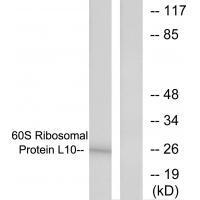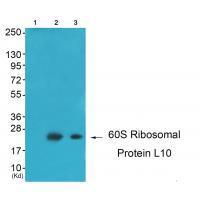Ribosomes, the organelles that catalyze protein synthesis, consist of a small 40S subunit and a large 60S subunit. Together these subunits are composed of four RNA species and approximately 80 structurally distinct proteins. This gene encodes a ribosomal protein that is a component of the 60S subunit. The protein belongs to the L10E family of ribosomal proteins. It is located in the cytoplasm. In vitro studies have shown that the chicken protein can bind to c-Jun and can repress c-Jun-mediated transcriptional activation, but these activities have not been demonstrated in vivo. This gene was initially identified as a candidate for a Wilms tumor suppressor gene, but later studies determined that this gene is not involved in the suppression of Wilms tumor. This gene has been referred to as 'laminin receptor homolog' because a chimeric transcript consisting of sequence from this gene and sequence from the laminin receptor gene was isolated; however, it is not believed that this gene encodes a laminin receptor. Alternative splicing results in multiple transcript variants. This gene also uses multiple polyA signals, with the 3'-most polyA signal overlapping the deoxyribonuclease I-like 1 gene on the opposite strand. This gene is co-transcribed with the small nucleolar RNA gene U70, which is located in its fifth intron. As is typical for genes encoding ribosomal proteins, there are multiple processed pseudogenes of this gene dispersed through the genome.
Dowdy S.F., Nucleic Acids Res. 19:5763-5769(1991).
van den Ouweland A.M.W., Hum. Mol. Genet. 1:269-273(1992).
Kaneko K., Hum. Mol. Genet. 1:529-533(1992).


